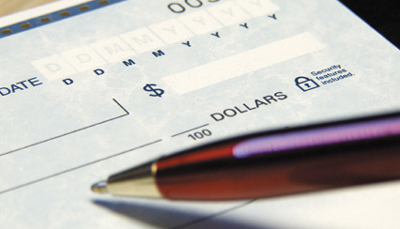
You find a high quality pro (professional) tennis racquet in a sports shop. The salesperson tells you that all of the racquets are on sale today.
A: We're offering a 50% discount today on all name brand racquets on the floor.
B: Good. How much is this one with the discount?
A: You've chosen a top-of-the-line racquet. The regular price on the tag is $599. With 50% off, it only comes to $299.50.
B: Sounds like a good deal to me, but I don't have that much cash with me right now.
A: No problem. Do you have a personal cheque and two pieces of I.D.?
B: Here's my driver's licence and my student card.
A: Fine. Please also give us your name, address and phone number on your cheque.
B: Good, I'll write it on the back of my cheque.
你在一大體育用品店看到一隻職業網球手用的球拍,店員告訴你今天所有球拍都以特價出售。
甲:我們今日以半價發售店內所有名牌球拍。
乙:太好了,這隻球拍折扣以後多少錢?
甲:你剛選中了一隻頂級的網球拍,標籤上的標準價是599元,五折後的價錢是299元5角。
乙:似乎不錯,不過我隨身沒有那麼多現金。
甲:那不成問題,你有沒有一張私人支票及兩張身份證明文件?
乙:這是我的駕駛執照和學生證。
甲:好,請在支票上寫下你的名字,地址和電話號碼。
乙:好,我現在便寫在支票背面。
Language Notes 語文註解:
(1) Discount——折扣。
(2) Name brand racquet——名牌球拍。Racquet可指網球拍、壁球拍或羽毛球拍。
(3) Floor——地面。此處指店內的範圍。
(4) Top-of-the-line——頂級。
(5) Regular price——平時的價錢。
(6) Sound like a good deal——聽來似乎十分划算。
(7) Cash——現鈔。
(8) Personal cheque——私人支票。
(9) I.D.=Identity——指身份證明文件。
(10) Driver's licence——駕駛執照。你的駕駛執照上有你的相片、地址和電話號碼。在加拿大,駕駛執照是最方便及最常用的身份證明文件。






